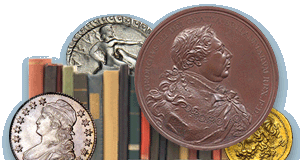
PREV ARTICLE
NEXT ARTICLE
FULL ISSUE
PREV FULL ISSUE
ROMAN PROVINCIAL COIN ATTRIBUTIONS SUGGESTEDLast week David Pickup asked for assistance identifying a Roman Provincial coin that had some members of the Oxford Numismatic
Society stumped. Here's what readers thought. -Editor
  Javier Arce, Prof. Emeritus Roman Archaeology, University Lille3 (France) writes: In my opinion, it is clearly a labarum and therefore, the coin should be Constantinian (after 313 AD). In the portrait, we can see also the diadem, that is clearly also Constantinian. The mention of the Legio Tertia is not so unusual in some issues in bronze in the period. On our Flickr photo archive, Stuart writes: Caracalla? The most detailed reply came from Mark Fox of Michigan. Thanks! -Editor
Aren't Roman provincials fascinating? I didn't quite expect to be making a contribution of this nature for The E-Sylum, but here it goes... The bronze in question is an issue of Rhesaena (today's Ra's al-'Ayn, Syria) in the Roman province of Mesopotamia (part of modern Iraq, Syria, and other countries), struck for the emperor Caracalla (AD 198–217). The Roman provincial coinage of Rhesaena contains some of the crudest coins struck under the Romans that I have ever seen, especially those minted during the reign of Caracalla's numismatic twin, Elagabalus (AD 218–222). Engravers aglow with talent by comparison were responsible for cutting most of the dies under later emperors, particularly Trajan Decius (249–251). David's coin is in remarkably good condition with a clear reverse and good centering on both sides, despite the irregular flan. The reverse appears to read "LEG III / P S," probably referring to Legio III Parthica, the Roman legion that was stationed at Rhesaena. Here is a similar example with the letter 'Γ' on the vexillum.  http://www.acsearch.info/search.html?id=9508 The legends might also differ slightly in their content. They are almost always hard to read on the early coins, even on the best preserved specimens. For the star-on-vexillum variety (as in David's example), we have these two specimens in the online BnF database: http://catalogue.bnf.fr/ark:/12148/cb417437260/PUBLIC 
 http://catalogue.bnf.fr/ark:/12148/cb41847296x/PUBLIC They illustrate the carelessness and/or inexperience of both engraver and minter, and the difficulty of interpreting these coins because of these problems. The reverse of the second coin, for instance, is pictured upside down! For a wider view of the coinage, I recommend having a peek at the Rhesaena web page on Wildwinds: http://www.wildwinds.com/coins/greece/mesopotamia/rhesaena/t.html
http://catalog.hathitrust.org/Record/001668060 If someone needs help, I probably could dig up a catalog reference from this monograph for David's coin, or at least the listed type that it most closely resembles. Hope this helps. David Pickup writes: Please pass on my thanks to Mark for this. I appreciate the work he has put into this. I certainly found it a challenging coin! I agree with the Rhesaena link. Caracalla it is. Thanks again, everyone! -Editor
To read the earlier E-Sylum article, see: Wayne Homren, Editor The Numismatic Bibliomania Society is a non-profit organization promoting numismatic literature. See our web site at coinbooks.org. To submit items for publication in The E-Sylum, write to the Editor at this address: whomren@gmail.com To subscribe go to: https://my.binhost.com/lists/listinfo/esylum All Rights Reserved. NBS Home Page Contact the NBS webmaster 
|
